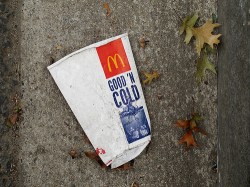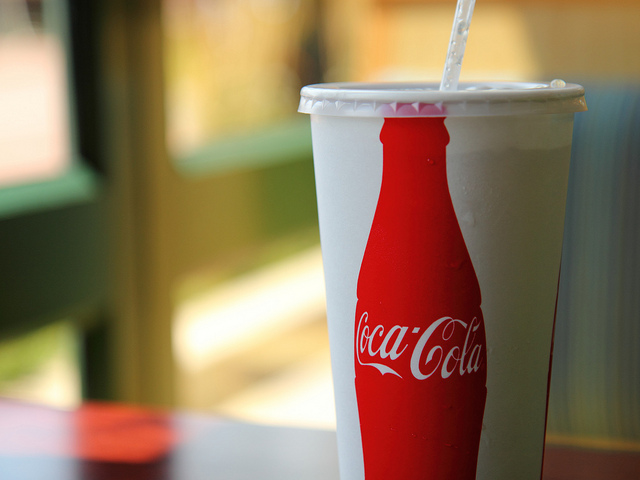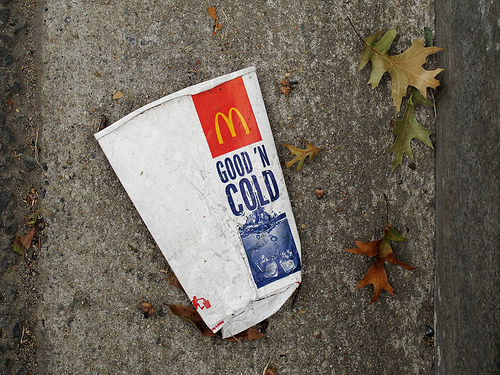
The new ban could crush McDonald’s ongoing cup size creep. (Photo by Mr. T in DC.)
Today, the New York City Board of Health approved Mayor Michael Bloomberg’s proposal to limit the size of sugary soft drinks.
Motivated by rising diet-related chronic diseases (along with healthcare costs), the mayor’s attempt to rein in out-of-control portion sizes has caused quite a media firestorm. Predictably, the soda lobby came out swinging, complete with an industry front group called, “New Yorkers for Beverage Choices.” A better name might be, “Soda Pushers for Continued Profits.”
According to Beverage Digest, fountain sales (versus packaged) make up about 24 percent of the 9.3 billion cases of soda sold each year, or $18 billion in a total market worth $75.7 billion.
Coca-Cola will be especially impacted by cup size limits, as that company controls 70 percent of U.S. fountain sales, followed by Pepsi with 19 percent and Dr Pepper Snapple with 11 percent.
While it’s obvious that the soda industry would be on the defense, largely missing from the debate so far has been the role of the fast food and the restaurant industry as a significant driver of soft drink sales. (Due to legal constraints, the city’s soda proposal would only apply to food service establishments and not retailers, i.e. grocery stores.)
The fast food industry has gotten plenty of flak for pushing a diet of cheeseburgers, French fries, and other highly processed pseudo-foods, but they should also be recognized as a major seller of sugary beverages.
For example, McDonald’s has allowed cup sizes to creep from a reasonable 7 ounces in 1955, to the current 32 ounces (310 calories for Coke), a more than 4-fold increase. Even the current child’s size, at 12 ounces, is almost twice as large as the original.
Fast food king McDonald’s has already expressed its displeasure with cup size limits, suggesting instead “a more collaborative and comprehensive approach.”
And it’s no wonder, since Edward Jones estimates that 5 percent of McDonald’s revenue comes from soft drinks. Last year, McDonald’s revenue reached a record $27 billion. That means at least $1.35 billion came from beverages (!)
That figure may be an underestimate because, according to the research firm Technomic, carbonated soft drinks account for about 10 percent of fast food and “fast casual” restaurants sales in the U.S.
Factor in the profit margins on such beverages — estimated to top 90 percent — and, as Ad Age noted, “the potential impact on the bottom line becomes clear.”
Whatever the figures, the money at stake here is huge — for both the soda companies and the fast food companies.
This explains why “New Yorkers for Beverage Choices” includes not only the major soft drink companies but many restaurant chains, including: Carls’ Jr, Chick-Fil-A, Domino’s Pizza, Hardee’s, and of course, the National Restaurant Association, whose members include McDonald’s.
That trade group, along with its network of state restaurant associations, boasts more than 200 national, state, and local lobbyists. The restaurant industry has fought against many nutrition policies over the decades, including menu labeling and regulating marketing to children.
Speaking of children, the downsizing of soft drinks will have an important impact on their sense of what’s “normal.” McDonald’s has been teaching kids that supersized fries, Big Macs, and large sodas are A-OK. Lowering cup-sizes could impact the health of a generation.
And that’s another reason McDonald’s and the rest of the fast food industry has been teaming up with the soft drink lobby to stop this proposal. They don’t want kids to grow up thinking 16 ounces is normal, because that means setting kids up for a lifetime of saner (and healthier) drinking habits.
The industry also knows that once limits are enacted in New York City, it’s only a matter of time before other cities around the nation follow Mayor Bloomberg’s lead.



